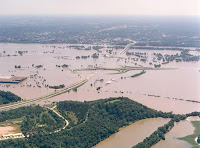The greatest threat of climate change to civilization over the next 40 years is likely to be climate change-amplified extreme droughts and floods hitting multiple major global grain-producing "breadbaskets" simultaneously. A
Food System Shock report issued in 2015 by insurance giant Lloyds of London outlined a plausible extreme shock to global food production that could cause rioting, terrorist attacks, civil war, mass starvation and severe losses to the global economy. Their scenario, which Lloyds gave uncomfortably high odds of occurring--significantly higher than 0.5% per year, which works out to at least an 18% chance of occurrence in the next 40 years--goes like this:
A strong El Niño event develops in the equatorial Pacific Ocean. Severe drought typical of El Niño hits India, eastern and southeastern Australia and Southeast Asia, causing the following crop losses (note that wheat, rice and corn make up over 50% of all agricultural production world-wide):
- India (world's #1 rice and #7 wheat exporter): wheat -11%, rice -18%
- Vietnam (world's #2 rice exporter): rice -20%
- Australia (world's #3 wheat exporter): wheat -50%
- Bangladesh, Indonesia, Thailand, Philippines: rice -6% to -10%
Historic flooding hits Mississippi and Missouri rivers, reducing production of corn in the U.S. by 27%, soybeans by 19% and wheat by 7%. Nepal, Bangladesh, northeastern India and Pakistan see large crop losses due to torrential rainfall, flooding and landslides, with Pakistan losing 10% of their wheat crop.
Read more at
Food System Shock: Climate Change's Greatest Threat to Civilization

No comments:
Post a Comment